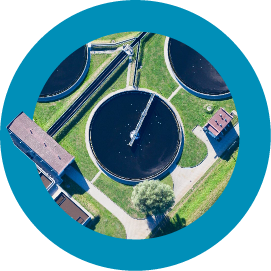
Brackish water is water with high enough salinity, that makes it not suitable for human consumption and requires treatment. Groundwater and surface water sometimes classify as brackish and will require advanced treatment solutions to make them suitable for such usages.
Water treatment requires physical, chemical, and, in some cases, biological treatment.
The type and order of processes required to treat groundwater/surface water depends on the type and concentration of contaminants that need to be treated
Chemical processes include oxidation, coagulation, and disinfection. Physical process includes flocculation, sedimentation, filtration, adsorption and disinfection
At IDE we offer a complete range of municipal water treatment solutions:
Clarification
Clarifiers, being a primary part of any water treatment plant, work on a principle of gravity settling to remove suspended particles, which as a result reduces the turbidity and TSS of the raw water. Depending on the presence of inlet suspended solids, a coagulation and flocculation process can also be envisaged at the inlet of the clarifier. Settled solids from the underflow of the clarifier are collected and transported to the sludge treatment area.
This process is suitable for removing / treating high levels of Turbidity and TSS, as well as oil
Lamella Clarifiers
Lamella clarifier serves to remove heavy particles by settling into inclined plates. This separation method requires prior flocculation and coagulation steps. Lamella clarifier is designed to maximize the settling efficiency of suspended particles with minimal footprint.
This process is suitable for removing / treating Turbidity and TSS
Multi-Media Filter (MMF)
A multi-media filter is used to reduce the level of suspended solids in process water by filtration through the granular media. The filtration degree of a multi-media filter depends heavily on the filter media and flow (velocity) through the filter. Gravity or pressurized filters are used for multi-media filtration and depend on feed water quality, quantity and intake location. As particles become trapped in the media, the differential pressure across the bed increases. High velocity backwash of the filter media is used to clean and revert the performance.
This process is suitable for removing / treating low levels of Turbidity and TSS, algae and organic matter
Ion-Exchanger (IX):
Ion exchangers (IX) are used to remove hardness or natural organic matter (NOM) present in the raw water. Based on the raw water analysis, IX uses suitable types of resins to exchange selective dissolved ions with any other ion. After the operating cycle, exhausted resin can be regenerated using chemicals.
In general, softener (IX) is used to treat hardness (Ca & Mg Ions) present in the raw water, which can further prevent scale formation in the water distribution network.
Similarly, presence of NOM in raw water can contribute to unwanted taste and odor, brownish-yellowish color & even the bacterial growth in the water distribution system. Ion Exchanger (IX) is also a solution to treat NOM present in well water & in some cases, even without the use of chlorination. Consequently, this method can prevent the formation of disinfection by-products (DBYs).
This process is suitable for removing / treating a large variety of contaminates and challenges, such as PFAS, hardness and TDS
Nano Filtration System:
Nanofiltration (NF), like RO, is a pressure-driven membrane separation process with the difference in the pore size of the NF membranes. NF membranes have larger pores, as compared to RO membranes, and show greater rejection of the divalent ions, as well as for the NOMs present in the raw water.
This process is suitable for removing / treating divalent ions such as Calcium, Magnesium and Sulphate
Lime Soda Softening
A chemical precipitation method to remove the hardness in the raw water. In this method, chemicals such as lime (CaO/Ca(OH)2) and/or sodium carbonate (Na2CO3) is added to the raw water, based on the water chemistry, to remove the permanent as well as temporary hardness.
This process is suitable for removing / treating Calcium and Alkalinity
Stripping Tower (Degasser Tower) and Scrubbing Towers
Depending on the geography, H2S contamination in wells is a common challenge. Since H2S has a distinctive smell, and leads to corrosion in the water distribution network and has various health concerns, removing it is a necessity. Degasification is one of the most effective techniques to reduce dissolved gas such as H2S or CO2 from the raw water. Degasser towers use a packed bed vertical tower to reduce dissolved gas such as CO2, H2S from the raw water. In some cases, scrubbing of the removed gasses is required and a scrubbing tower is installed.
This process is suitable for removing / treating Hydrogen Sulphide, Carbon Dioxide, Ammonia and Volatile Organic Matter
UF (Ultrafiltration)
Ultrafiltration (UF) is a membrane filtration process which uses hydrostatic pressure to force water through a semipermeable membrane. The pore size of the ultrafiltration membrane, usually 0.01 to 0.1 micrometers (microns), creates a pressure-driven barrier to suspended solids, bacteria, viruses, endotoxins and other pathogens to produce water with very high purity and low silt density.
Contact an IDE Expert
Would you like more information about our technologically advanced solutions?










